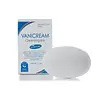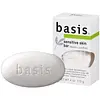What's inside
What's inside
 Benefits
Benefits

 Concerns
Concerns

 Ingredients Side-by-side
Ingredients Side-by-side

Sodium Cocoyl Isethionate
CleansingStearic Acid
CleansingWater
Skin ConditioningCoconut Acid
CleansingSodium Isethionate
CleansingSodium Lauroyl Sarcosinate
CleansingSodium Laurate
CleansingSorbitol
HumectantPropanediol
SolventCetearyl Alcohol
EmollientGlyceryl Stearate
EmollientSimethicone
EmollientSodium Chloride
MaskingPetrolatum
EmollientCeteareth-20
CleansingPEG-30 Stearate
EmulsifyingPEG-20
HumectantTitanium Dioxide
Cosmetic ColorantSodium Tallowate
CleansingSodium Cocoate
CleansingSodium Palm Kernelate
CleansingWater
Skin ConditioningGlycerin
HumectantPetrolatum
EmollientPrunus Amygdalus Dulcis Oil
Skin ConditioningTitanium Dioxide
Cosmetic ColorantSodium Thiosulfate
Chamomilla Recutita Flower Extract
MaskingAloe Barbadensis Leaf Extract
EmollientCyclopentadecanone
MaskingPentasodium Pentetate
Tetrasodium Etidronate
Emulsion StabilisingLanolin Alcohol
EmollientBeeswax
Emulsion StabilisingSodium Tallowate, Sodium Cocoate, Sodium Palm Kernelate, Water, Glycerin, Petrolatum, Prunus Amygdalus Dulcis Oil, Titanium Dioxide, Sodium Thiosulfate, Chamomilla Recutita Flower Extract, Aloe Barbadensis Leaf Extract, Cyclopentadecanone, Pentasodium Pentetate, Tetrasodium Etidronate, Lanolin Alcohol, Beeswax
 Reviews
Reviews

Ingredients Explained
These ingredients are found in both products.
Ingredients higher up in an ingredient list are typically present in a larger amount.
Petrolatum is more commonly known as petroleum jelly. It is created by mixing waxes and mineral oils.
This ingredient is effective at reducing water loss by 99%. This is because it is an occlusive. Occlusives create a hydrophobic barrier on the skin to prevent evaporation. This property makes it great for hydrating dry skin.
Pro tip: Use occlusives, such as this ingredient, on damp skin for the best results.
The quality or origin of petrolatum is only known when disclosed by the brand. Most cosmetic petrolatum has gone through several purification stages.
Another benefit of occlusives is it protects your skin against infection or allergies.
Petrolatum may not be safe for fungal-acne. Studies show mineral oil / petroleum leads to the growth of M. Furfur, a type of yeast.
Learn more about PetrolatumTitanium dioxide is a mineral UV filter widely used in sunscreens and cosmetics.
It is one of only two UV filters officially classified as “mineral” by regulatory agencies, the other being zinc oxide.
Titanium dioxide provides broad-spectrum protection mostly in the UVB and UVAII range, with some protection in the UVAI range.
While its UVA protection isn’t as strong as zinc oxide’s, the difference is minor.
A common myth is that mineral UV filters reflect UV light. However, modern research shows titanium dioxide absorbs UV radiation like chemical filters (~95% absorption & 5% reflection).
Thanks to its non-irritating nature, titanium dioxide is suitable for sensitive, acne-prone, or redness-prone skin. It is unlikely to cause "eye sting" like other sunscreen ingredients.
A major drawback of this ingredient is its white cast and thick texture. This is why mineral sunscreens often leave a white cast and are less cosmetically elegant than chemical/hybrid sunscreens.
To improve white cast and spreadability, micronized or nano-sized titanium dioxide is often used.
There are ongoing concerns surrounding nano-titanium oxide's impact on marine ecosystems.
There is no conclusive evidence that any form of titanium oxide (or any other sunscreen ingredients) will cause harm to marine ecosystems or coral reefs. The science is still developing but many consumers are keeping a close eye on this issue.
Please note, many destinations have reef-safety sunscreen rules. For instance, the U.S. Virgin Islands advises all visitors to use non-nano mineral sunscreens.
Nano mineral sunscreens once raised safety concerns about absorption into skin.
Extensive research has shown that they do not penetrate healthy or damaged skin; they remain safely on the surface and the top layer of dead skin (stratum corneum).
You'll likely find titanium dioxide bundled with alumina, silica, or dimethicone. These ingredients help make titanium dioxide highly photostable; this prevents it from interacting with other formula components under UV light.
Learn more about Titanium DioxideWater. It's the most common cosmetic ingredient of all. You'll usually see it at the top of ingredient lists, meaning that it makes up the largest part of the product.
So why is it so popular? Water most often acts as a solvent - this means that it helps dissolve other ingredients into the formulation.
You'll also recognize water as that liquid we all need to stay alive. If you see this, drink a glass of water. Stay hydrated!
Learn more about Water